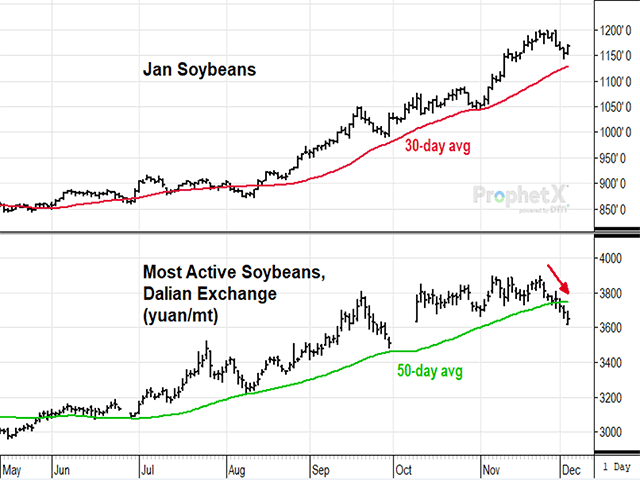Todd's Take
New Clues for Soybean Futures
Just two weeks ago, I wrote about the dynamics of a bull market in soybeans and tried to explain that there are a lot of emotional factors at work when supplies get as tight as they have become. The trend in January soybeans is still up, and I can't rule out beans in the teens when U.S. ending supplies may be as low as 100 million bushels (mb) or less in 2020-21. Much depends on China's demand and how South American weather treats the new crop season.
As I also mentioned in the Nov. 20 column (https://www.dtnpf.com/…), the clock can strike midnight before anyone expects. In that vein, I have to mention two bearish concerns that came to light this week.
First, rain started showing up in the 10-day forecast for central Brazil on Monday, and the rain chances persist Thursday. In central Brazil, Mato Grosso is the largest producing state for both soybeans and second-crop corn. Conditions have been dry so far, with soybeans starting to flower.
The rain will clearly be beneficial to crops if it proves true, and it is no surprise that both U.S. and Brazilian soybean prices fell lower the first three days of this week (Nov. 30 to Dec. 2). Brazil's FOB soybean price for March suffered technical damage Wednesday as it closed below the 30-day average for the first time since Sept. 1 and stayed below it on Thursday.
P[L1] D[0x0] M[300x250] OOP[F] ADUNIT[] T[]
If rain were this week's only bearish factor, the bull market in soybeans would still look promising, as China's demand has been the main driving force of higher prices. However, China's spot soybean price on the Dalian exchange has fallen 3% since Friday's close, only partly due to rain in Brazil's forecast.
Spot soybean prices on the Dalian exchange had been trading above their 50-day average since May, flattened out after early October, and clearly closed below the 50-day average Wednesday, Dec. 2.
Because we don't have access to reliable soybean market information within China, the soybean price on the Dalian exchange has been our best clue as to what has been happening. China's soybean prices started posting new highs in mid-July, about the same time we saw FOB soybean prices in Brazil hit new highs. As we later discovered, China had been buying Brazilian soybeans much more aggressively than usual.
China's prices kept rising as we witnessed their voracious appetite shift from Brazil to the U.S. in late July. China's active pace of U.S. soybean buying continued, even through their holiday week in early October, before purchase amounts started steadily declining the past seven weeks.
Once back from holiday, China's spot soybean price began to level out, and a double-top formed at 3,899 yuan per metric ton in November. This week's break of upward momentum may have been partly influenced by rain in Brazil's forecast, but I suspect it is also a bearish clue that China's appetite for soybeans is finally weakening.
Calling a top in a market where soybean supplies are extremely tight is a risky venture, and I'm not confident about throwing in the towel yet -- not when ending stocks are probably near 100 mb and U.S. January soybeans are still in an uptrend. But it is also very risky for noncommercials to be holding 281,730 net longs in soybeans as of Nov. 24 when nobody knows for sure what is happening in China or how South America's weather will turn out.
For those keeping score, the 37-cent drop in January soybeans from Friday to Wednesday cost speculators a little over a half-billion dollars. For many that rode the trend up, the loss is still house money, but one of these days, noncommercials may wake up to feel a bigger pinch.
With that stakes high and plenty of uncertainty ahead, it is easy to understand why tight-supply markets are so emotional and difficult to predict. For producers that haven't yet sold 75% of their 2020 soybean production, I encourage you to consider putting more in the bank. I can't guarantee how this will turn out, but I can say the latest price message from China is not encouraging for soybean bulls.
Todd Hultman can be reached at Todd.Hultman@dtn.com
Follow him on Twitter @ToddHultman1
(c) Copyright 2020 DTN, LLC. All rights reserved.






